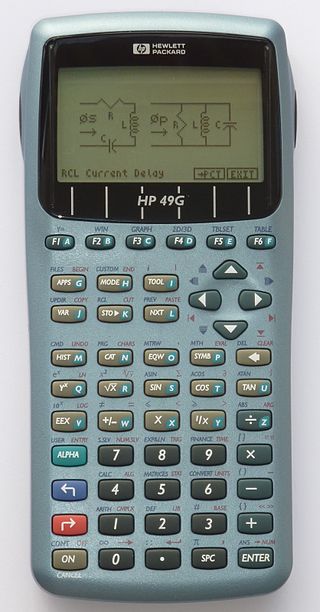
The HP 49/50 series are Hewlett-Packard (HP) manufactured graphing calculators. They are the successors of the popular HP 48 series.
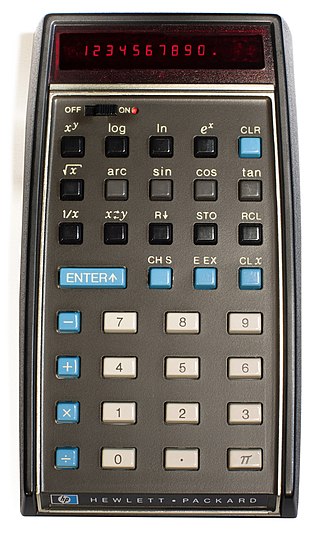
The HP-35 was Hewlett-Packard's first pocket calculator and the world's first scientific pocket calculator: a calculator with trigonometric and exponential functions. It was introduced in 1972.

The HP-65 is the first magnetic card-programmable handheld calculator. Introduced by Hewlett-Packard in 1974 at an MSRP of $795, it featured nine storage registers and room for 100 keystroke instructions. It also included a magnetic card reader/writer to save and load programs. Like all Hewlett-Packard calculators of the era and most since, the HP-65 used Reverse Polish Notation (RPN) and a four-level automatic operand stack.
RPL is a handheld calculator operating system and application programming language used on Hewlett-Packard's scientific graphing RPN calculators of the HP 28, 48, 49 and 50 series, but it is also usable on non-RPN calculators, such as the 38, 39 and 40 series. Internally, it was also utilized by the 17B, 18C, 19B and 27S.
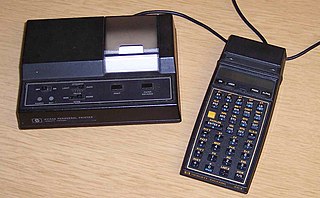
The HP-41C series are programmable, expandable, continuous memory handheld RPN calculators made by Hewlett-Packard from 1979 to 1990. The original model, HP-41C, was the first of its kind to offer alphanumeric display capabilities. Later came the HP-41CV and HP-41CX, offering more memory and functionality.

The HP-20S (F1890A) is an algebraic programmable scientific calculator produced by Hewlett-Packard from 1987 to 2000.

The HP-42S RPN Scientific is a programmable RPN Scientific hand held calculator introduced by Hewlett-Packard in 1988. It has advanced functions suitable for applications in mathematics, linear algebra, statistical analysis, computer science and others.
Engineering notation or engineering form (also technical notation) is a version of scientific notation in which the exponent of ten is always selected to be divisible by three to match the common metric prefixes, i.e. scientific notation that aligns with powers of a thousand, for example, 531×103 instead of 5.31×105 (but on calculator displays written without the ×10 to save space). As an alternative to writing powers of 10, SI prefixes can be used, which also usually provide steps of a factor of a thousand. On most calculators, engineering notation is called "ENG" mode as scientific notation is denoted SCI.
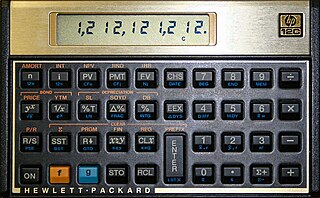
The HP-12C is a financial calculator made by Hewlett-Packard (HP) and its successor HP Inc. as part of the HP Voyager series, introduced in 1981. It is HP's longest and best-selling product and is considered the de facto standard among financial professionals. There have been multiple revisions over the years, with newer revisions moving to an ARM processor running a software emulator of the original Nut processor. Critics claim that its 1980s technology is antiquated, but proponents point out that it is still the de facto and de jure in high finance.
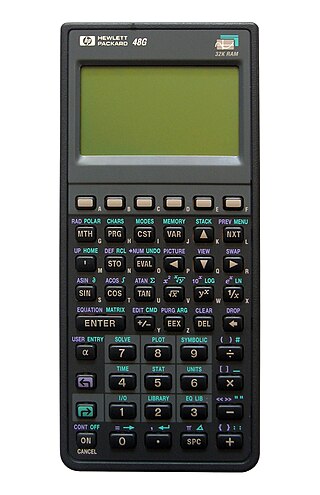
HP calculators are various calculators manufactured by the Hewlett-Packard company over the years.

The Hewlett-Packard Voyager series of calculators were introduced by Hewlett-Packard in 1981. All members of this series are programmable, use Reverse Polish Notation, and feature continuous memory. Nearly identical in appearance, each model provided different capabilities and was aimed at different user markets.

The HP-25 was a hand-held programmable scientific/engineering calculator made by Hewlett-Packard between early January 1975 and 1978. The HP-25 was introduced as a cheaper alternative to the ground-breaking HP-65.

The HP-19C and HP-29C were scientific/engineering pocket calculators made by Hewlett-Packard between 1977 and 1979. They were the most advanced and last models of the "20" family and included Continuous Memory as a standard feature.
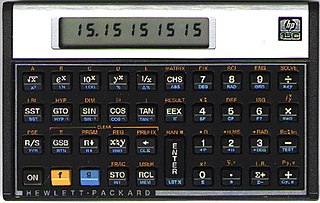
The HP-15C is a high-end scientific programmable calculator of Hewlett-Packard's Voyager series produced between 1982 and 1989.
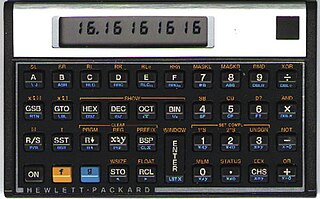
The HP-16C Computer Scientist is a programmable pocket calculator that was produced by Hewlett-Packard between 1982 and 1989. It was specifically designed for use by computer programmers, to assist in debugging. It is a member of the HP Voyager series of programmable calculators. It was the only programmer's calculator ever produced by HP, though many later HP calculators have incorporated most of the 16C's functions.

The HP 35s (F2215A) is a Hewlett-Packard non-graphing programmable scientific calculator. Although it is a successor to the HP 33s, it was introduced to commemorate the 35th anniversary of the HP-35, Hewlett-Packard's first pocket calculator. HP also released a limited production anniversary edition with shiny black overlay and engraving "Celebrating 35 years".

The HP-55 was a programmable handheld calculator, a lower-cost alternative to the HP-65. Introduced by Hewlett-Packard in 1975, it featured twenty storage registers and room for 49 keystroke instructions. Its outward appearance was similar to the HP-65, but its silver band went through between the display and the keyboard like HP-45, and the functions of some keys were different from HP-65, and it did not have a magnetic card reader/writer. Like all Hewlett-Packard calculators of the era and most since, the HP-55 used Reverse Polish Notation (RPN) and a four-level automatic operand stack.

The Packard Ninth Series Light Eight Model 900 was an automobile model produced by the Packard Motor Car Company of Detroit, Michigan only during model year 1932. The Light Eight was planned as a new entry model, building off the 1928 Packard Six. It competed in the upper middle-class with makes like GM's Companion Brand LaSalle, Marquette and Chrysler's DeSoto, and the top-level products from Studebaker, Hudson, and Nash. The marketing objective was to add a new market segment for Packard during the depression.

The HP-67 is a magnetic card-programmable handheld calculator, introduced by Hewlett-Packard in 1976 at an MSRP of $450. A desktop version with built-in thermal printer was sold as the HP-97 at a price of $750.

The HP Prime Graphing Calculator is a graphing calculator introduced by Hewlett-Packard in 2013 and manufactured by HP Inc. until the licensees Moravia Consulting spol. s r.o. and Royal Consumer Information Products, Inc. took over the continued development, manufacturing, distribution, marketing and support in 2022. It was designed with features resembling those of smartphones, such as a full-color touchscreen display and a user interface centered around different applications. It claims to be the world's smallest and thinnest CAS-enabled calculator currently available.



















